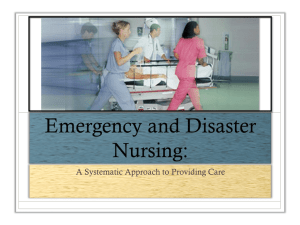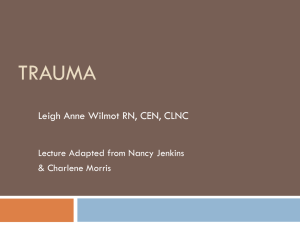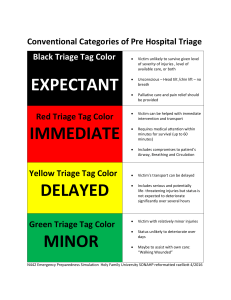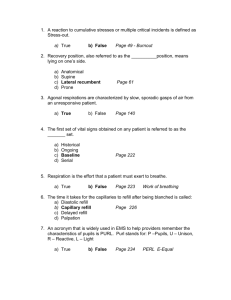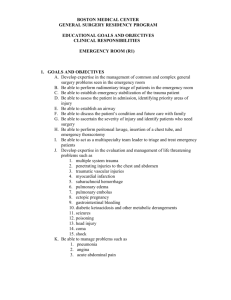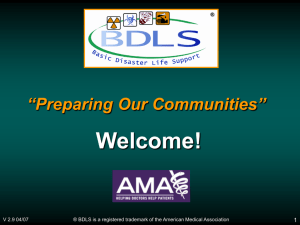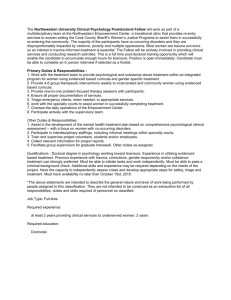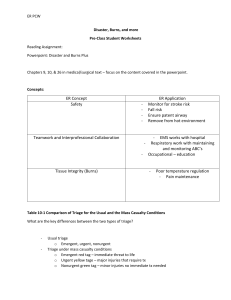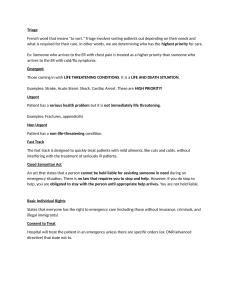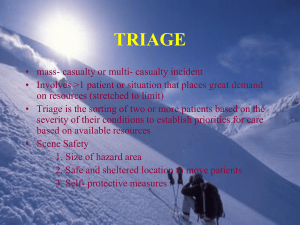Triaging Pain in the ED - Austin Community College
advertisement
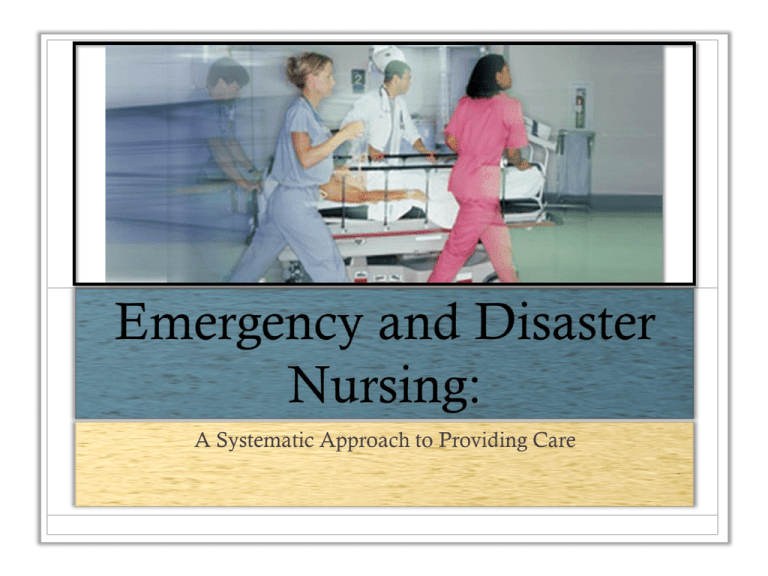
•1/3 of hospital care begins in the emergency department • The majority of ED patients require immediate care • In 2003, 114 million visits to Emergency Rooms occurred • Since 1993, there has been a 14-percent decrease in the number of Emergency Departments nationwide. • In the 1990’s, hospitals lost 103,000 staffed inpatient medical/surgical beds and 7,800 ICU beds. • In 2004, nearly 70 percent of urban hospitals went on diversion to ambulances citing lack of critical care beds. American Hospital Association (2006). Prepared to care: The 24/7 standby role of America’s full service hospitals. Retrieved September 28, 2009 from http://www.aha.org/aha/research-and-trends/AHA-policy-research/PreparedToCareIndex.html American College of Emergency Physicians (2004). Report from a roundtable discussion: Meeting the challenge of emergency department overcrowding/boarding. Retrieved September 28, 2009, from http://www.acep.org/workarea/downloadasset.aspx?id=34350 • Level One: Resuscitation – patients require immediate evaluation and management • Level Two: Emergent – patients require evaluation within 15 minutes for potential threats to life or limb • Level Three: Urgent – patients have conditions that cause significant discomfort and should be evaluated within 30-60 minutes • Level Four: Less Urgent – patients do not require rapid intervention, but should be evaluated within 60 minutes • Level Five: Non-urgent – patients may be seen in a delayed fashion and could be referred to other areas of the health care system Prah Ruger, J., Lewis, L.M., & Richter, C.J. (2007). Identifying high-risk patients for triage and resource allocation in the ED. American Journal of Emergency Medicine. 25, 794-798. • Assessed while maintaining Cervical Spine • Signs and symptoms of compromised airway • Jaw Thrust Maneuver • Causes • Assessment • Treatment • Central Pulse is Checked • Color, Temperature, Moisture AMS and delayed capillary refill are the most • significant signs of shock • 2 large bore IV’s with NS or LR • Level of Consciousness • Glasgow Coma Scale • Pupil Size Expose – remove all clothing (special consideration for forensics) Full Set of Vital Signs Family Presence Five Interventions Give Comfort History and Head to Toe Assessment Trauma victims are often victims or perpetrators of crime Work collaboratively with law enforcement Maintain the chain of evidence • Blood type and cross • Blood alcohol level • Urine drug screen • Pregnancy test • What others can you think of ? • X-Ray, CT, MRI • Diagnostic Peritoneal Lavage (DPL) • Abdominal Ultrasound Focused Assessment with Sonography for Trauma (FAST) Blood, crystalloids –NS or LR, volume expanders Hespan Inotropic drugs after IV fluids Dopamine, dobutamine, isoproterenol Vasopressors dopamine, epinephrine Opioids - pain control Tetanus prophylaxis Antibiotics Mannitol • Atypical presentations • Cognitive Impairment • Co-morbidities • Polypharmacy – Coumadin, Beta-blockers, Anti-hypertensives Hwang, U., Richardson, L.D., Sonuyi, T.O., & Morrison, R.S. (2006). The Effect of emergency department crowding on the management of pain in older adult with hip fracture. Journal of the American Geriatric Society. 54, 270-275. Crosses all socioeconomic and sociocultural barriers 1.5 million women and 834,000 men treated at ED’s have been battered by persons known to them Make referrals, provide emotional support, inform victims about their options, ensure patient safety Suspected abuse of elders, persons with disabilities and children MUST be reported by law. It is not an option to assume the social worker or doctor will report. Assessments conducted in less than 15 seconds… System of colored tags to determine seriousness of injury and likelihood of survival Total number of casualties a hospital can expect is estimated by doubling the number of casualties that arrive in the first hour. • Injury identification-rapid assessment at scene • Penetrating injuries to abdomen, pelvis, chest, neck or head • Spinal cord with deficit • Crushing injury to head, chest or abdomen • Major burns • Critical interventions • providing life support, immobilizing the cervical spine, managing the airway, and treating hemorrhage and shock • Rapid transport-ASAP to regional trauma center MIEMSS A V P U A V P U A V P U • Patient Information • Triage Status • Tourniquet @ _______ Chief Complaint Extremity Splint Gauge HOSP NOTIFIED • Transportation • Peel - off Bar Codes • Transport Record • Vital Signs • History • Treatment PASG Inflated at _______________ Gross Decon. Final Decon. TRIAGE TAG Maryland Emergency Medical Services Maryland Department of Transportation • Major obvious injuries or illness can be circled • Indicate injuries on the human figure • Additional information is added on the comments line • Paramedics communicate with ED • Brief report about client with ETA • Severity of condition determines ED response • Champion Revised Trauma Scoring System Nursing Diagnosis • Ineffective airway clearance • Altered tissue perfusion • Impaired gas exchange • Risk for infection • Impaired physical mobility • Spiritual distress • Risk for post-trauma syndrome • Risk for patients and caregivers • Emotions range from fear, anger denial and shock. • May experience flashbacks and nightmares • Recognition of our own values and perceptions • Need for evidenced based practice • Continuing education through inservices and online training • Department specific policies – no more than 8 hours in triage • Use of a different triage ranking system such as ESI where specific complaints are automatic level assignments
